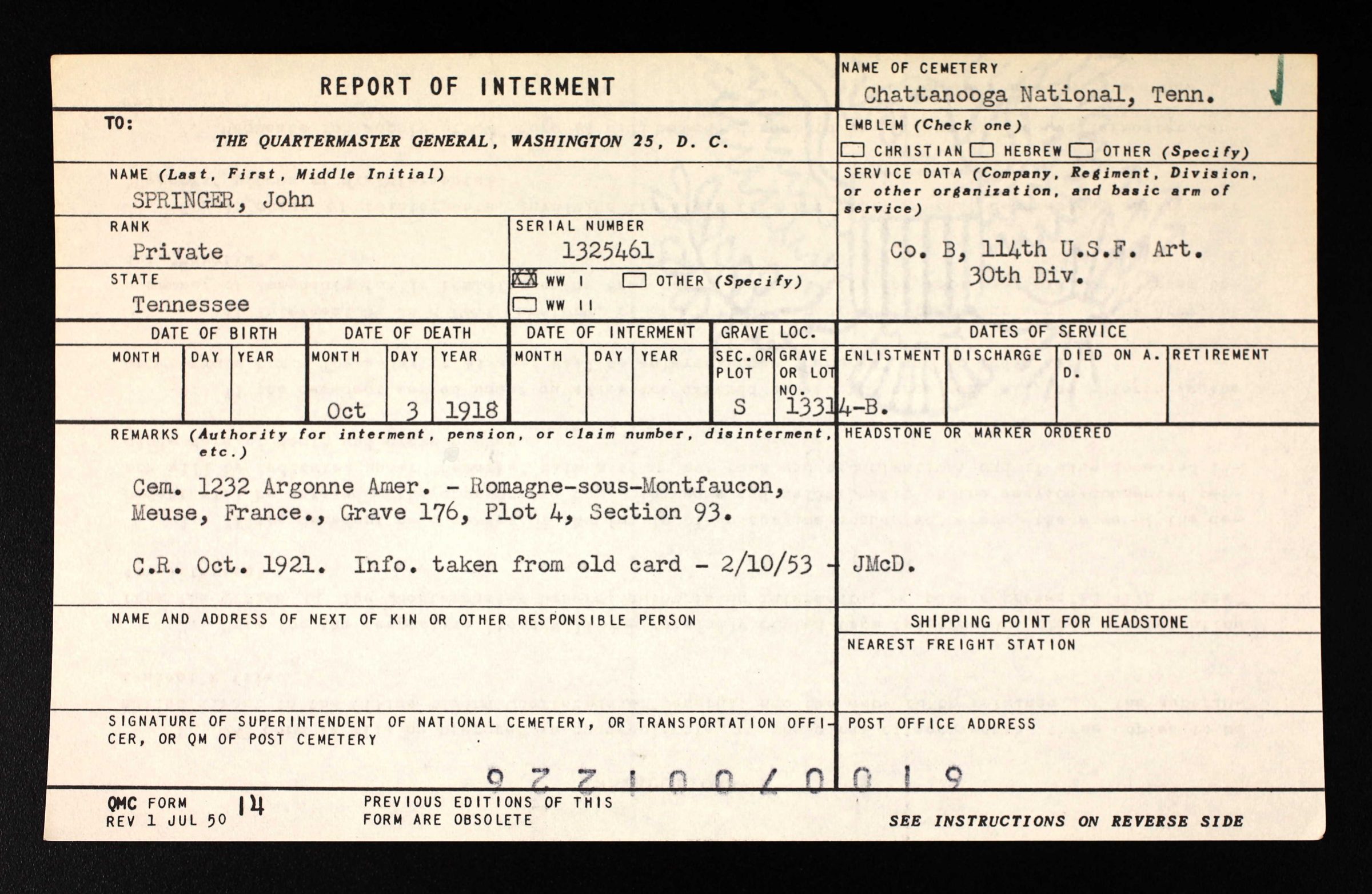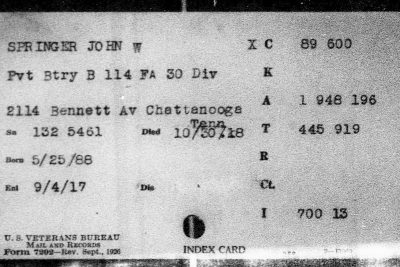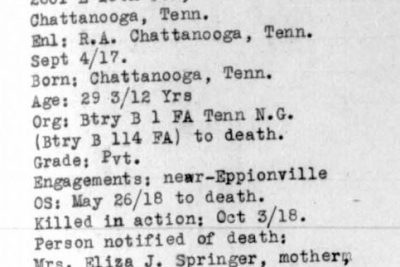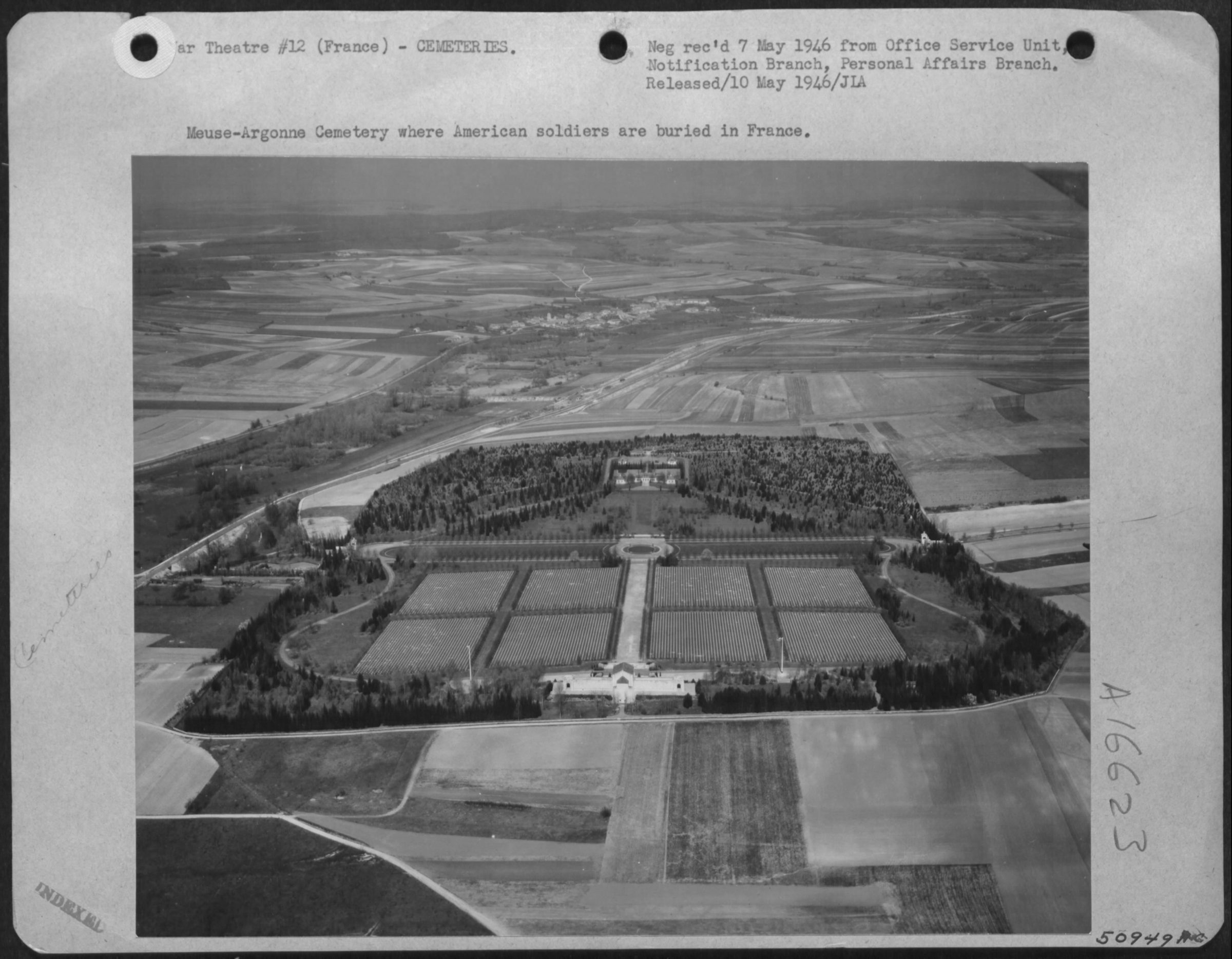Private John W. Springer
Birth: May 1888, Graysville, Catoosa County, Georgia, USA
Died 3 October 1918 in France
Battalion B, 114th Field Artillery;
Killed in action at Epionville, France, 3 October 1918
Originally buried at Argonne American Cemetery, Romagne-sous-Montfaucon, France
Buried Chattanooga National Cemetery, S, 13314-B
From The Chattanooga Times (October 12, 1921) page 3:
The body of John Springer, a Chattanoogan who was killed overseas in 1918, arrived in the city last night. Funeral service will be held from Wann’s this afternoon at 2 o’clock, the Rev. John W. Inzer, national chaplain of the American Legion, officiating.
The deceased was a soldier of the 114th field artillery regiment, and the body comes from the great American battlefield cemetery at Romagne-sous-Montfaucon. Final burial will take place in the National cemetery this afternoon. E.P. Taylor, Lon McSpadden, Joe Worty, L.H. Johnson, Fred Parks and George Meacham have been designated as pallbearers.
In the early summer of 1917, John Springer left a department foreman’s position at the plant of the O.B. Andrews company to enlist in the Chattanooga battery of the hastily recruited Tennessee light field artillery regiment.
As a caner, private, first-class, Springer helped Battery B win a French training camp firing trophy-an order to fire the 55th F.A. brigade’s first shot in defense of the Tour sector. In the St. Mihiel opening barrage, he served a .75 on most the exact site of the Flirey monument, the recent unveiling of which was the main object of a pilgrimage to France by a large delegation of American legionnaires.
Springer was killed instantly Oct. 3, 1918 by a German box barrage, bracketed upon the Chattanooga battery and the 126th infantry, in a now-famous apple orchard north of Epionville near Montfaucon. The 126th infantry (Thirty-second division) had just come up to relieve the shattered left wing of the Thirty-seventh division, which was being relieved. For many hours, this apple orchard was between the infantry assault line and support battalions. Springer and his compadres had been there since Sept. 30th, helping Ohio infantry hold the orchard. Local ex-artillerymen generally regard this as their toughest, position, either side of Verdun-certainly the worst hole in the Meuse-Argonne area.
In the casualty list that resulted from the battery’s “sacrifice role” north of Epionville was the instant death of William F. Ramsey, of East Lake–a young caisson corporal who was shot down while bringing artillery ammunition up to infantry positions. Ramsey’s death occurred on the day after Springer’s and the two were buried near one another, reburied in the battlefield rendezvous at Romagne, and brought back to America on the same transport. Ramsey’s body is expected from Hoboken.
The phase of the battle in which these Chattanoogans were killed is picturesquely described in the history of the 146th infantry (“Heaven, Hell or Hoboken” by Ray N. Johnson, machine gunner, Cleveland, O.). After listing members of his company who fell during a German counter attack near the apple orchard, Johnson’s “infantry story” runs:
“All of us who were left had miraculous escapes; through showered time and again with flying dirt and rock, and sprayed with shrapnel, we came through safely.
In the corner of an apple orchard we reorganized our depleted command and took up our assigned positions in support of three batteries of artillery.
(All three were batteries of Tennessee ‘accompanying guns’)
Our nerves were now in a state of collapse, continues the infantry narrative. Several men were slightly gassed and some were suffering from temporary shell-shock. The expected counterattack failed to materialize, and it was asserted, even by the officers, that we must soon be relieved. Needless to say, we all prayed that it come quickly, but the weary hours passed on and there were not signs of it. We dug in along the roadside in preparation for the night. Meanwhile the rain continued.
All night the artillery on the hillside crashed and roared as they harassed the enemy. We were so near the guns that the shock of their explosions rocked the very ground beneath us and seemed to nearly split our eardrums. These were what were known as sacrifice batteries, placed in emergency virtually on the front lines.
Monday was raw and cold. There had been no change in orders, and we remained in support of the sacrifice batteries.
Thus died John Springer and William Ramsey in the apple orchard that thinly sheltered ‘a sacrifice battery.’ “
- Rank: Private
- Date of birth: 25 May 1888
- Date of death: 3 October 1918
- County: Hamilton
- Hometown: Chattanooga
- Service Branch: Army
- Division/Assignment: Battery B, 114th Field Artillery, 30th Division
- Theater: Europe
- Conflict: World War I
- Battles: Argonne, near Eppionville
- Burial/Memorial Location: Chattanooga National Cemetery, Chattanooga, TN
- Location In Memorial: Pillar III, Middle Panel
- Contact us to sponsor John W. Springer
Image Gallery
Click a thumbnail below to view at full size.









